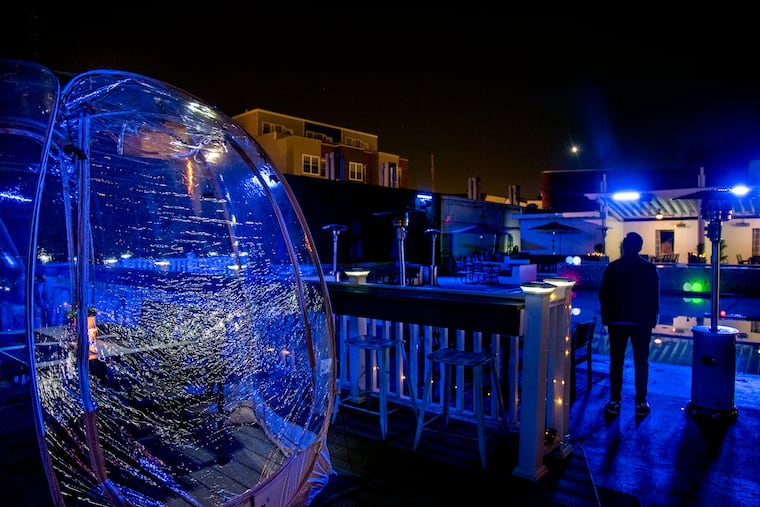How these Philadelphia restaurants are not only surviving the pandemic, they’re ‘doing well’
“ ‘Doing well,’ for many, means surviving,” said one restaurateur.

Through the sleepless nights, the layoffs, closings, reopenings, closings, downsizings, illness, PPE, PPP, and more closings and reopenings, many independent restaurateurs are counting their blessings. They’re still in business, hoping that this next round of federal relief — including the $29 billion Restaurant Revitalization Fund grants — will help keep them afloat.
“There’ve been a lot of ups and downs the last year,” said Nicole Marquis, who owns HipCityVeg and the bars Charlie was a sinner and Bar Bombon, and founded the lobbyist group Save Philly Restaurants. “‘Doing well,’ for many, means surviving.”
“Doing well” is relative, of course. If a landlord will allow a tenant to forgo rent or pay a percentage of sales instead of a flat rent, he or she may be doing “well.” If the restaurant was able to turn quickly to takeout or delivery, it may be doing well. If the restaurant was able to keep staff and convert its government loan into an outright grant, it may be doing well.
But first, realize that it is likely that few if any of the region’s smaller restaurant operators are doing as well as the tightly run chain restaurants, which are now stars on Wall Street. Take Brinker International, the $3 billion company that owns Chili’s and Maggiano’s Little Italy. On Jan. 24, 2020, as the news of the coronavirus began spreading around the world, a share of Brinker sold for $45.77. The stock entered a free fall, bottoming out at $9.31 on March 20, 2020. But it steadily began rising, reaching $77 a share on March 15, 2021, before retreating slightly.
Modesty or ego generally forbid those who own privately held restaurants to share specifics about their businesses, much less go public with any news of good fortune — not when $270 billion in national sales were reportedly lost. Many of their contemporaries lost their homes and livelihoods, and so many people are still out of work.
Sales at local pizzerias, usually strong in any economy, seemed to be solid year over year, even as other kinds of restaurants entered the delivery market. (Of course, the stock of Yum! Brands, which owns Pizza Hut, is up 56% year over year.) New pizzerias created more competition, as did ghost kitchens, which flooded the marketplace with delivery options.
New revenue
There was no single magic bullet. Managing outdoor dining helped. Derek Gibbons and Tim Liu of GLU Hospitality closed their bars and turned toward their restaurants, for which they ramped up delivery early on. They bought 15 igloo-like dining bubbles for Germantown Garden Grill at their Vesper Dayclub in Northern Liberties and marketed the heck out of them — creating a financial success out of a bar that used to close after Labor Day. On a typical Monday night, Gibbons said, the location will feed 200 to 300 people. This newfound revenue is helping offset the lack of income from their bars such as Leda & the Swan, which recently reopened, and Vesper in Center City.
“I don’t think we can say, ‘Oh, we made more money this year.’ The bottom line is that we were able to keep our doors open,” said Carlos Melendez, who owns the Mexican restaurant Coyote Crossing in Conshohocken, whose outdoor dining area operates year-round. The pandemic gave him the opportunity to start fresh, including a new chef and a tighter menu for delivery, a new revenue stream. He owns his real estate, “so I feel blessed.”
Pren Kqira decided to double down with his Lakeview Cafe in Royersford, which opened in early 2018 and was starting to turn a profit. Because takeout wasn’t enough to sustain him and his 12 employees, and outdoor dining wasn’t an option during the cold months, he struck a deal to expand into the space next door. This doubled capacity while still maintaining social distancing and occupancy standards.
David Taing and Kenny Poon, whose half-dozen restaurants are mainly in Chinatown and University City, said they saw strong numbers at their Bonchon chicken franchise locations, making up for some of the dine-in revenue that is only now returning. Delivery-service fees were eating into that, though. “We’re doing about the same [income], but we’re spending more,” said Taing, itemizing the costs of additional takeout containers, PPE supplies, and cleaning crews.
Their Chinatown locations, including their Chinatown Square food hall, suffered for a while from the lack of walk-in business. “I think that people during the pandemic were scared of Chinatown,” Poon said. Many of their customers, who are University of Pennsylvania and Drexel University students, chose to patronize businesses in University City instead, he said. Their new restaurants include Nam Vietnamese Kitchen, whose opening they delayed until indoor dining was permitted.
Mike Strauss at Mike’s BBQ in South Philadelphia closed briefly before the city shutdown over safety concerns and reopened only with him and wife Eylonah in the back, one employee in the front, and an overnight dishwasher who never mingled with the others. The pace was grueling. They shut down frequently to rest. Early in the pandemic, with other restaurants shut down, Mike’s handled 200 sales tickets on a typical Thursday — four times the volume it did before the crisis.
All told, Strauss said year-over-year sales volume was off 25%, “but I consider that a win.”
For Marquis, although sales were off overall, “we thrived internally,” she said, counting her advocacy work and greater attention paid to improve the culture within her company.
Marquis believes in the oft-quoted statement that the nation will emerge from this pandemic with a strong hospitality climate, as the Roaring Twenties followed the 1918 flu. “There’s so much pent-up demand out there,” she said.